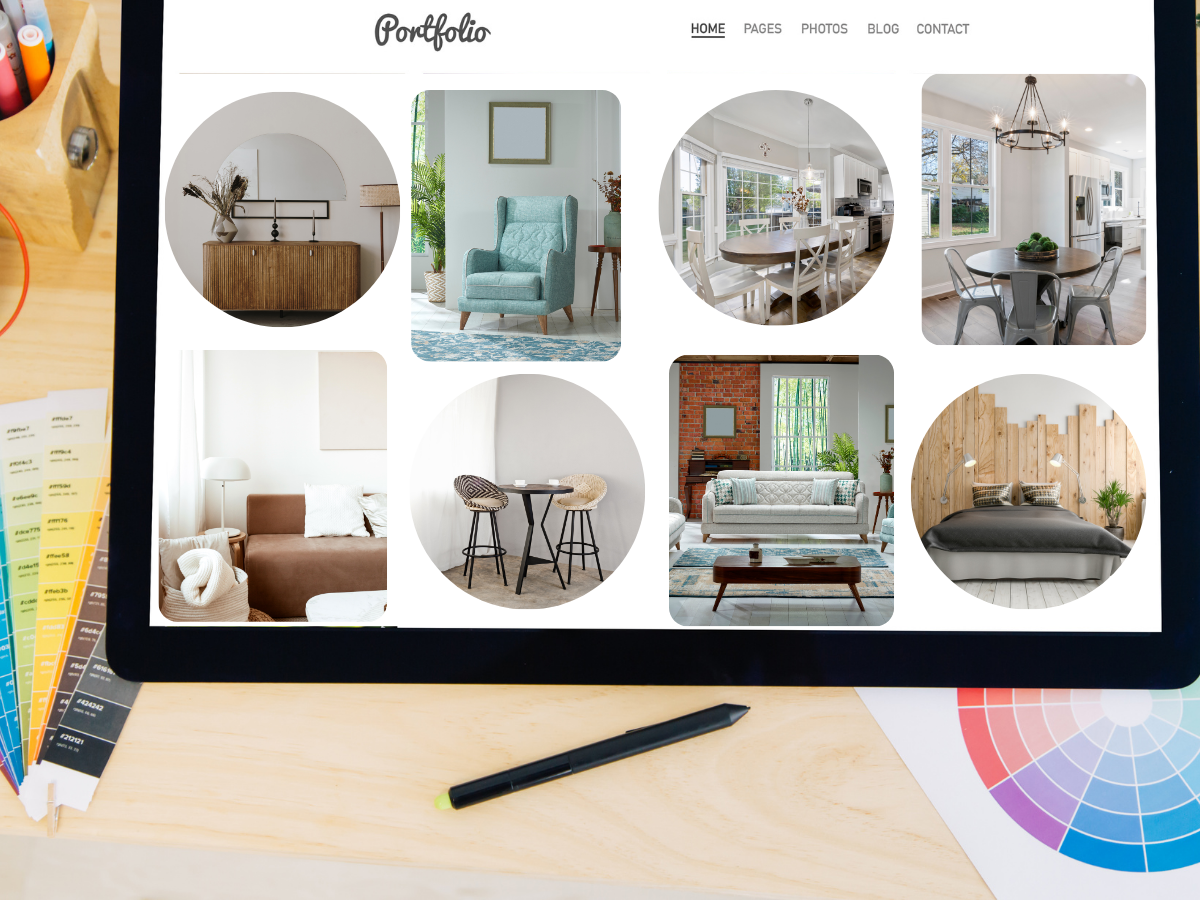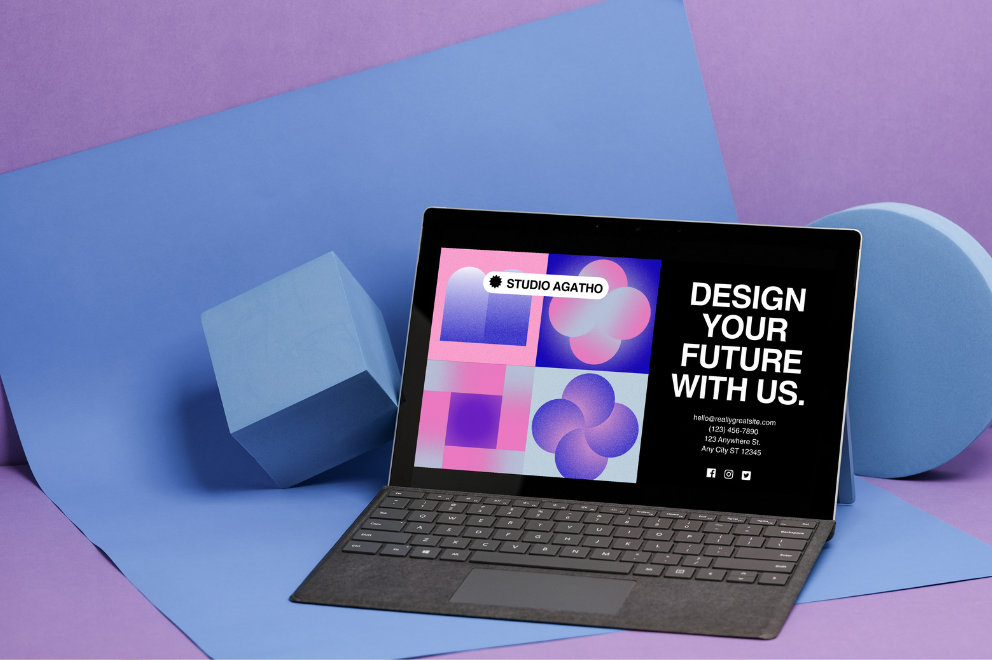
Creating a perfect interior design portfolio is essential for showcasing your skills and attracting potential clients or employers.
Here’s a step-by-step guide to help you build an impressive portfolio that reflects your unique design aesthetic and professional capabilities.

The portfolio visually shows the designers aesthetic and approach through images of completed projects, sketches and design concepts. So potential clients and employers can see the designers style and what they can do at a glance.
A portfolio is more than just a collection of work – it’s a visual tool that tells the story of who you are as a designer. Think of it as your shop window, where your creativity, skills and experience come together in one place. Your portfolio should show not just completed projects but also a glimpse into your process, your inspirations and your approach to space transformation. Through a mix of photos, 3D’s and sketches you can show how you make aesthetics and function come to life in your designs.
But why is a portfolio so important? In design, visuals trump words. Whether you’re applying for a job, bidding on a freelance project or applying to a design program, your portfolio is usually the first thing potential clients, employers or educators will see. It’s your chance to make a lasting impression and stand out in a crowded industry. A good portfolio doesn’t just show what you’ve done, it shows your potential and your vision, so it’s an essential tool for any interior designer who wants to succeed and progress in their career.

Building a great interior design portfolio is like designing a space – it takes thought, attention to detail and a bit of creativity. Whether you’re curating a digital or physical book, your portfolio should be a reflection of you and your professional journey. Here’s what you should include:
Start with a personal touch. Your About section is where you get to introduce yourself not just as a designer but as a storyteller. Share a little bit about what drives your passion for interior design – whether it’s love of transforming spaces, fascination with colors and textures or your journey from zero to hero. A professional yet friendly tone will help potential clients and employers connect with you on a personal level. Add a photo of you in action – whether that’s mid project or standing in a space you’ve designed.
This is the meat of your portfolio where your skills get to shine. Each project should tell a story, take the viewer from concept to completion. Include high quality images of your work, ideally before and after shots that show the transformation. Go beyond the images by adding context – what was the client’s brief, your process, any challenges you faced. Did you create mood boards, floor plans or sketches? Show these to demonstrate your process and creativity. Remember, potential clients want to see not just what you did but how you did it.
Your resumé is more than just a list of jobs and qualifications – it’s a design opportunity in itself. Make this section as beautiful as the rest of your portfolio. Use layout, color and typography to create a document that’s informative and pretty. Highlight key achievements, professional certifications and any notable projects. This is where you get to show you’re not just experienced but you’ve made a real impact in your industry.
Once you’ve wowed potential clients or employers with your work, make sure they can find you. Whether you dedicate a whole page to contact details or include them on every page, make sure it’s clear and easy to find. Consider adding your social media handles as these can give people a glimpse into your design process and personality. A simple Contact page with a form or direct email link can also boost your online presence and make it easy for people to get in touch.
Don’t be afraid to add your own personality to your portfolio with sections that are unique to you. A blog for example can showcase your thoughts on industry trends, design tips, or your experiences in the industry. If you have a solid client base consider adding a testimonials page – positive feedback is powerful. Finally, a Services page can clarify what you offer for clients who aren’t familiar with interior design. This can outline your areas of expertise – residential, commercial or sustainable design and provide another point of contact.

Creating a perfect interior design portfolio is essential for showcasing your skills and attracting potential clients or employers. Here’s a step-by-step guide to help you build an impressive portfolio that reflects your unique design aesthetic and professional capabilities.
First things first, you need to create a digital space for your work to live in—a portfolio website. This will be the home for all your design projects, personal story and professional info. You don’t have to be a tech genius to get started; modern website builders like Squarespace, Wix and WordPress make it easy. Choose a template that suits your style, customize the layout and pick a colour scheme that matches your brand. Must haves are an About page, a Projects page, a Resumé page and a Contact page.
Next is the About page. This is where you introduce yourself and connect with potential clients or employers. Start with a short but sweet intro—who you are, what drives your love of design, and a snapshot of your experience. Keep it friendly but professional and don’t forget to include a call to action that encourages visitors to look at your work or get in touch. Once you’ve written your About section, ask friends or colleagues for feedback then refine the text before adding it to your site.
Your projects are the meat of your portfolio. Choose the best of your work that showcases your skills and range. When creating your interior design portfolio, you want to showcase a variety of samples that show off your skills and versatility as a designer. Your examples don’t have to be completed client projects, include creative elements like renderings, sketches, or even color palettes that show your design style.
Just choose pieces that fit your brand image and design aesthetic. For example, if you specialize in contemporary and mid-century modern, prioritize those styles. If you specialize in eclectic or bohemian design, make sure your portfolio showcases those.
You also need to tailor your portfolio to your audience. If you’re pitching to a client with a specific taste—say an art deco office—include examples that fit their vision. Remember decision makers only spend a few minutes looking at portfolios so you want to show only your best work. Quality over quantity is the rule here; choose pieces that really show off your skills and leave a lasting impression.
One of the biggest challenges of an interior design portfolio is to get your work organized in a way that’s cohesive and easy to follow. A well curated portfolio allows potential clients or employers to find the most relevant examples of your work quickly. To do this your portfolio needs to be logically laid out, easy to browse, and aligned with your brand. If you have a lot of different samples consider categorizing them by style, room type, or even in chronological order to create a flow.
Wherever you decide to organize your portfolio, make sure your best work is at the top. So if the viewer only spends a minute or two browsing they’ll see the best of you.
As a designer, you might feel more comfortable letting your visuals do the talking but sometimes a few well chosen words can add a lot of value. Pair your design images with brief descriptions of each project. You can share about the tools and techniques used, the client’s brief, your approach to the project, and any challenges you faced and overcame. Also, make sure to highlight your role in each project.
These help potential clients or employers understand your design process and how you think. But remember to keep it brief – enough to give context without overpowering the images. Just enough to add to the story.
Adding your resumé is easy but important. Focus on highlighting relevant experience and qualifications that support your interior design expertise. Your resumé should be short—emphasize key roles and achievements rather than every job you’ve ever had. Have someone review it for errors or areas for improvement. This is as much about presentation as it is about content so make sure it’s polished and professional.
Before you hit that publish button take the time to review your portfolio thoroughly. Check that the site matches your brand, that all links work, and that the navigation is easy to use. Check your text for errors and that the balance of images and content is visually appealing. Test the site on different devices to make sure it loads everywhere. Once you’re happy publish your portfolio and share it far and wide—especially on LinkedIn where potential clients or employers can find your work.
Your portfolio should tell what makes you, you. When considering how to make the perfect interior design portfolio, focus on work that shows your style and expertise. If you’re new to the industry, showcase your technical skills and creative process through sketches, renderings, and standout school projects. Experienced designers should highlight their best, most polished work, including high-profile or award-winning projects. Make sure you show what sets you apart from others in your field.
Think of your portfolio as a business card tailored to specific audiences. Different clients and employers will be looking for different specialisms, whether it’s residential, commercial or a niche like sustainable design. Tailor your portfolio to the type of work your potential client or employer needs. Show them relevant projects and how you would solve their specific problem.
While finished projects are important, showing your process can be what sets you apart. Include process drawings, mood boards, material research and before-and-after photos. These give insight into how you turn concepts into final designs and show off your problem solving skills.
The presentation of your portfolio is just as important as the content, especially when you’re learning how to make the perfect interior design portfolio. Aim for clean, well-laid-out pages that enhance your work, not overwhelm it. Use consistent formatting, limit font styles, and ensure your images are well-cropped and aligned. Your layout should be beautiful and professional, free from clutter or distractions.
Consider creating different versions of your portfolio. A printed version can make a great impression when you meet in person, while a digital version is essential for online applications. A mini-portfolio or lookbook can be a concise, portable preview. Tailor each version to the client or job, show them you’ve thought about their specific needs.
Your portfolio should evolve with you. Update it regularly with new projects and remove old work. Stay up to date with industry trends and add fresh ideas and designs to your portfolio. This keeps your portfolio relevant and shows your growth as a designer.
By integrating these tips into your portfolio creation process, you’ll present a compelling, professional, and unique representation of your design talents.
A portfolio is essential for demonstrating your design abilities, attracting clients, securing jobs, and standing out in the competitive interior design industry.
Quality over quantity is key. Aim for a concise portfolio that highlights your best work without overwhelming the viewer—typically 10-15 projects are sufficient.
Focus on showcasing your design process, technical skills, and any relevant personal or school projects. You can also create hypothetical projects to demonstrate your abilities.
Use a clean and professional layout, include process images and stories behind your designs, and customize your portfolio to reflect your unique style and strengths.
To make the perfect interior design portfolio, you need a portfolio that stands out to showcase your skills and attract clients or employers. By selecting your best work, organizing it effectively, and keeping it up-to-date, you can make an impact in the interior design world. Whether you’re just starting out or have years of experience, a well-crafted portfolio is your ticket to new opportunities and success. Keep it fresh, relevant, and true to you, and you’ll be ready to wow at every turn.

James Sullivan, an architect with a degree from the University of Texas, has focused on sustainable beach house designs since 2013. He joined our team in 2020, weaving his expertise into articles that emphasize harmony with nature. James enjoys scuba diving during his weekends.

Hi there! I’m Aisha Harper. With a background in exploring breathtaking destinations and a deep appreciation for creating warm, inviting spaces, I’ve combined my passion for adventure and home into a fulfilling career. From scaling mountains to styling living rooms, I love blending the thrill of the outdoors with the comfort of home, inspiring others to do the same.